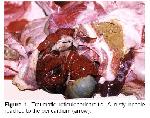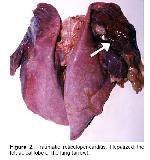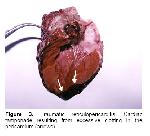 |
 |
| [ Ana Sayfa | Editörler | Danışma Kurulu | Dergi Hakkında | İçindekiler | Arşiv | Yayın Arama | Yazarlara Bilgi | E-Posta ] | |
| Fırat Üniversitesi Sağlık Bilimleri Veteriner Dergisi | |||||||
| 2010, Cilt 24, Sayı 2, Sayfa(lar) 103-105 | |||||||
| [ Özet ] [ PDF ] [ Benzer Makaleler ] [ Yazara E-Posta ] [ Editöre E-Posta ] | |||||||
| Bir Keçide Traumatik Retikuloperikarditis | |||||||
| Aydın ÇEVİK1, Necati TİMURKAAN1, Fethi YILMAZ2 | |||||||
| 1Fırat Üniversitesi Sivrice Meslek Yüksekokulu Elazığ, TÜRKİYE 2Fırat Üniversitesi Elazığ Sağlık Yüksekokulu Elazığ, TÜRKİYE |
|||||||
| Anahtar Kelimeler: Keçi, patoloji, traumatik retiküloperikarditis | |||||||
| Özet | |||||||
Bu çalışmada bir keçide rastlanan traumatik retikuloperikarditis olgusu tanımlandı. Olguda, klinik olarak genel sağlık durumunda kötüleşme ve solunum güçlüğü, makroskobik olarak, karın boşluğunda sıvı birikimi ve lokal fibrinli peritonitis gözlendi. Retikulumun anteroventral bölgesi ile diyafram arasında şiddetli fibröz yapışmalarla birlikte 5 cm uzunluğunda paslı bir iğne vardı. Gögüs boşluğunda purulent bir eksudat, akciğerin sol apikal lobu ile perikard arasında da fibröz yapışmalar belirlendi. Perikard boşluğunda aşırı kanamaya bağlı kalp tamponadı tablosu gözlendi. Gögüs ve karın boşluğunda ayrıca çok sayıda apselere rastlandı. Histopatolojik olarak, retikulum, perikard, epikard ve akciğerlerde fibrinopurulent yangısal bir reaksiyon gözlendi. |
|||||||
| Giriş | |||||||
Traumatic reticulopericarditis results from injury or perforation of the reticulum and pericardium by sharp foreign bodies 1, 2. Foreign bodies such as nail, piece of wire, or needle are ingested with feed and reach the reticulum. The objects causing no perforation might remain in the reticulum for some time without causing harm 2. However, objects which pass through the reticulum can cause bleeding, abscess and adhesion in surrounding tissues and organs 3, 4. Objects which proceed in a cranioventral direction may cause reticulopericarditis by perforating the diaphragm or the pericardium 1, 5. Although reticulopericarditis is known to occur in cattle, it is rarely observed in small ruminants 6-8. The present study identified a case of reticulopericarditis in a goat with macroscopic and microscopic findings. |
|||||||
| Olgu Sunusu | |||||||
In this study, an 19-month-old female goat was observed to have deteriorated in general condition, with excessive weight loss and dyspnea, and the necropsy was performed. The tissue samples from visceral organs such as heart, lungs, liver, reticulum, peritoneum were fixed in 10% neutral buffered formalin, embedded in paraffin, tissue sections were stained with hematoxylin and eosin (HE). Macroscopically, 200 ml of yellowish ascitic fluid with fibrin clots was observed in the abdominal cavity. The reticulum, liver, diaphragm and peritoneum contained numerous fibrous adhesions. A rusty needle, 5 cm in length, which reached to the pericardium, was found (Figure 1). There were also many abscess foci in adhesion areas. Approximately 1000 ml fibrinopurulent exudate was observed in the thoracic cavity. The left apical lobe of the lung was found to be hepatized (Figure 2). Between the pleura and pericardium, there were greenish to yellow fibrous adhesions and abscess foci. Cardiac dilatation, pericardial thickening and cardiac tamponade resulting from excessive clotting in the pericardial sac were observed (Figure 3). Furthermore, there was petechial hemorrhage of the endocardium.
Microscopically, neutrophil leukocytes, macrophages, a few lymphocytes, fibrin fibriles and a proliferation of connective tissue were found in the pleura, epicardium and pericardium. The inflammatory reaction was more severe in the pericardium. Variably sized abscesses surrounded by a wide zone of fibrous capsule were seen in the affected lobe of lung. Local connective tissue proliferation along with numerous neutrophil leukocytes and mononuclear cell infiltrations were observed in the reticular wall and peritoneum. Inflammatory cell reaction and connective tissue proliferation in Glisson's capsule were also found in the liver. No remarkable lesion was seen in the other organs. |
|||||||
| Tartışma | |||||||
Traumatic reticuloperitonitis/pericarditis develops as a consequence of perforation of the reticulum by foreign bodies 1. The presence of potentially injurious materials are very important in development of the disease 3, 8. Sharp objects which reach the reticulum can not penetrate internal organs unless the intra-abdominal pressure rises 5. Increased intra-abdominal pressure due to pregnancy and ruminal tympany may facilitate the penetration of the foreign body into the reticular wall and other abdominal and thoracic organs 2. The object may stay there or it can penetrate through the diaphragm and causes traumatic reticulopericarditis 6, 7. The animal in the present case gave birth two months previously and, hence pregnancy and/or parturation seemed important in the development of the disease as in earlier reports implied 2. The macroscopic and microscopic findings of the case are in agreement with the literature 1,6, 8. The prognosis for reticulopericarditis is poor and the disease generally results in death. Although reticulopericarditis is known as a cattle disease 2,3, it is rarely observed in small ruminants 6-8. This case shows that the potential risk of this condition should be taken into consideration for small ruminants. |
|||||||
| Kaynaklar | |||||||
1) Hoffsis GF. Traumatic pericarditis. In: Amstutz HE. (Editor). Bovine Medicine and Surgery 2nd Edition, Santa Barbara, PA: American Veterinary Publishers 1980: 753-756.
2) Brown CC, Baker DC, Barker IK. Forestomachs. In: Jubb KVF, Kennedy PC, Palmer N. (Editors). Pathology of Domestic Animals. 5th Edition, Vol 2, California: Academic Press Inc 2007: 41-51.
3) Braun U, Gansohr B, Haessig M. Ultrasonographic evaluation of reticular motility in cows after administration of atropine, scopolamine and xylazine. J Vet Med A Physiol Pathol Clin Med 2002; 49: 299-302.
4) Maddy KT. Traumatic gastritis in sheep and goats. J Am Vet Med Assoc 1954; 124: 124-125.
5) Sojka JE, White MR, Widmer WR, Van Alstine WG. An unusual case of traumatic pericarditis in a cow. J Vet Diagn Invest 1990; 2: 139-142.
6) Abo-Sheda MN, Al-Rawashdeh O, Al-Natour M. Traumatic pericarditis in an Awassi lamb. Br Vet J 1991; 147: 78-81.
|
|||||||
| [ Başa Dön ] [ Özet ] [ PDF ] [ Benzer Makaleler ] [ Yazara E-Posta ] [ Editöre E-Posta ] | |||||||
 |
| [ Ana Sayfa | Editörler | Danışma Kurulu | Dergi Hakkında | İçindekiler | Arşiv | Yayın Arama | Yazarlara Bilgi | E-Posta ] |


